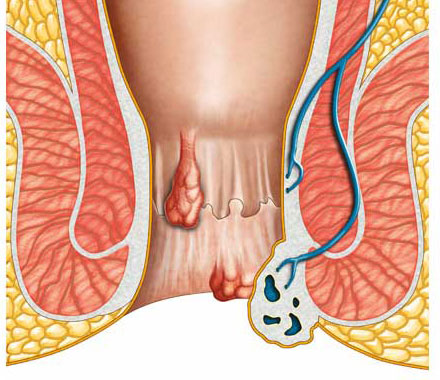Fistula in Ano
A fistula in ano is a tunnel like - pipe like track, developed in the perennial region, usually having one or more external openings around the anus leading to an internal opening in the mucosa of the anal canal or the rectum.
Anal fistula is also termed as "Bhagandara".
Anal Fistula, a rare condition, is a chronically inflamed, abnormal tunnel between the anal canal and the outer skin of the anus. It often drains watery pus, which can irritate the outer tissues and cause itching and discomfort.
How does it occur ?
An anal fistula usually results from an infection that forms in the tissue lining the anal canal. The infection may be caused by spread of bacteria that normally exist in the rectum. Occasionally, it may occur as a result of :
- A healed sore in the rectal area
- Ulcerative colitis, a disease associated with ongoing breakdown of tissues that causes a sore in the lining of the colon
- Diverticulitis, inflammation of harmless growths in the wall of the intestines
- Crohn's disease, a chronic inflammation of the intestines
- Tuberculosis
- Gonorrhea
- Cancer of the large intestine
What are the symptoms ?
Symptoms of anal fistula may include :
- A patient of fistula in ano often suffers from a recurrent, small or large boil/boils/abscess surrounding the anus, accompanied with pain, discomfort & pus/blood discharge.
- The symptoms subside when the boil / abscess burst spontaneously causing some more discharge for a couple of days.
- The boil / abscess "heals up" temporarily but almost always reappears after some times.
Itching, discharge of watery pus, irritation of tissue around the anus, discomfort & pain these are the main symptoms of the fistula in ano.
How is it diagnosed ?
To diagnose an anal fistula, the doctor will review your symptoms, give you a physical exam, and may use the following procedures:
- Anoscopy / Proctoscopy , a procedure in which the doctor inserts an instrument called an anoscope into the rectum to inspect the anus and lower part of the rectum
- Probing examination: a procedure in which the surgeon insert an instrument called anal probe it to the external fistulous opening to internal fistulous opening.
- Sigmoidoscopy , a procedure in which a doctor uses a flexible or rigid scope to inspect the lower part of the intestine for inflammation and/or disease
- A biopsy to evaluate for inflammation or cancer
- Lower gastrointestinal (gi) series, a procedure that uses a special fluid to show the intestines better on x-ray
- A lower gi series requires a clean, clear gi tract. The doctor will prescribe a special diet, including plenty of water, for the day before the procedure. In addition, you may be given an enema the morning of the procedure.
Causes :
- In a few cases there is a previous history of ano-rectal abscess.
- Some times a fissure in ano/ anal fissure gets infects & the infection travels down to form a track or a fistula.
However in most cases there are no definite causes found.
Possible contributing factors
- Tearing of the lining of the anal canal.
- Infection from an anal gland
- Chron's, ulcerative colitis, tuberculosis
Modes of treatments:
Anal fistulas are almost never found to heal spontaneously. The inner wall of the fistula develops fibers tissue & payogenic membrane not allowing spontaneous healings.
- The most commonly followed mode of treatment is laying open the entire track of the fistula and removing the fibrous tissue & payogenic membrane. This sometimes, in complex fistulas is done in two or more sittings.
- In certain cases a silk setone is passed through parts of the track.
- Laser Surgery (Fistulectomy / fistulectomy by laser beam)
- Laying open the fistula and applying a skin graft.
- Laying open, excision of the fistulous track and suturing the wounds.
- Coring out the fistulous track.
- Sealing with fibrin glue.
- Fistula Plug Management.
- VAFT Technique for anal fistula.
- Reconstruction with flap surgery for anal fistula.



